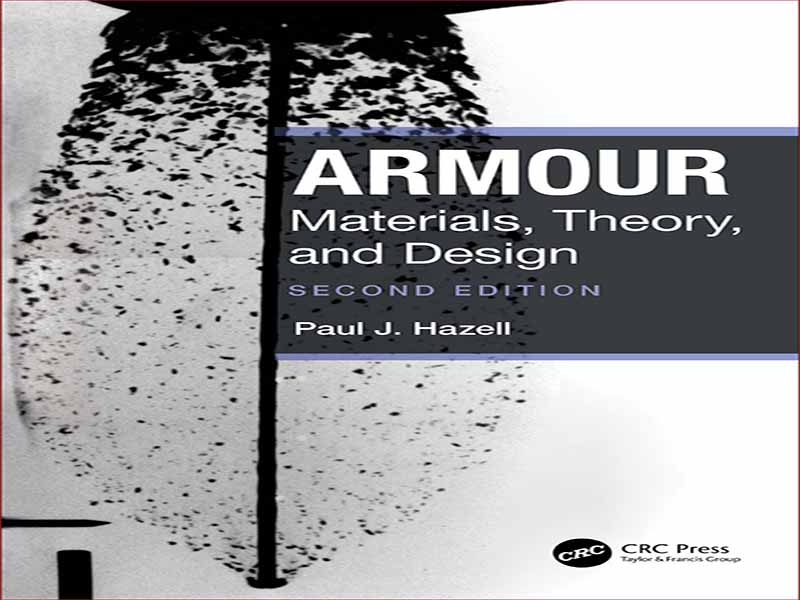- عنوان کتاب: Armour / Materials, Theory, and Design
- نویسنده/انتشارات: Paul-J-Hazell
- حوزه: تسلیحات نظامی
- سال انتشار: 2023
- تعداد صفحه: 499
- زبان اصلی: انگلیسی
- نوع فایل: pdf
- حجم فایل: 20.4 مگابایت
مفهوم زره به قدمت تپه هاست. نیاز به دفاع، محافظت، نجات، سپر و محافظت از آسیب در آگاهی انسان ریشه دارد. طبیعی است، میل به پیشرفت نیز همین طور است. پیشرفت در فناوری زره رخ داده است به طوری که ما دیگر به ضخامت بیشتر مواد برای ایجاد مقاومت در برابر نفوذ متوسل نمی شویم. در عوض، ما بر پیشرفت های جدید در فناوری مواد تکیه کرده ایم. این کتاب برخی از پیشرفتهای اخیر و علم پشت آنها را خلاصه میکند. اگر بخواهیم نموداری را ترسیم کنیم که تغییرات عملکرد زره را با زمان نشان دهد، هیچ شکی باقی نمیماند که حداقل در سالهای اخیر، گامهای بزرگی در فناوری زره برداشته شده است. معیاری که برای عملکرد زره استفاده می شود نسبتاً دلخواه است – می توان آن را به عنوان “برخی معیارهای عملکرد” بر اساس تراکم منطقه (یعنی جرم در واحد سطح) توصیف کرد. به عبارت دیگر، زره سبک تر که محافظت کافی را فراهم می کند چیز خوبی است. باز هم این مفهومی است که قدمتی به اندازه تپه ها دارد. این تصوری است که دیوید پسر چوپان هنگام جنگیدن با جالوت می دانست – زره سنگین و دست و پا چلفتی شاه شائول را به نفع سرعت و چابکی کنار زد (و یک شلیک بسیار خوب با زنجیر). البته، زره های سنگین، اگر بتوانید آن را بپوشید یا رانندگی کنید، اطمینان قابل توجهی را به شما می دهد. شاید این دلیل پشت تانکهای آلمانی پادشاه تایگر در جنگ جهانی دوم (جنگ جهانی دوم) بود که در منطقه 70 تن وزن داشتند. به عنوان یک ماشین جنگی، آنها منظره بسیار خوبی بودند و مرتباً ترس را به نیروهای متفقین وارد می کردند. این تانک ها به شدت زره پوش بودند و زره بدنه جلویی آنها 150 میلی متر ضخامت داشت. با این حال، آنها به طور منظم مستعد خرابی مکانیکی بودند که تا حدی به دلیل وزن زیاد آنها بود. و در نهایت، تنها 489 وسیله نقلیه از این نوع تولید شد (Ogorkiewicz، 1991). با معرفی تکنیک های پردازش پیشرفته، زره های واکنش دهنده انفجاری، مواد کامپوزیتی و مواد سرامیکی در حدود 30 تا 40 سال پیش، عملکرد سیستم های زرهی به طور چشمگیری بهبود یافت. این پیشرفتها کلیدی برای کاهش وزن زره بودند. پیشرفتهای بیشتر در عملکرد با مطالعه مکانیسمهای نفوذ پرتابهها در مواد زرهی با استفاده از تجهیزات تشخیصی با سرعت بالا مانند فلاش اشعه ایکس و عکاسی با سرعت بالا انجام شد. طراحی سیستم با توسعه کدهای تحلیلی و محاسباتی، با استفاده از دومی برای مطالعه مکانیسمهای نفوذ، تقویت شد. از آن زمان این کدها مهندسان را قادر می سازد تا طرح های مختلف زره را آزمایش کرده و مطالعات بهینه سازی را بدون ترک دفتر انجام دهند.
The concept of armour is as old as the hills. The need to defend, protect, save, shield and guard from harm is engrained within the human consciousness. It is natural, so too is the propensity to progress. Advancements in armour technology have occurred so that we are no longer resorting to ever-greater thickness of material to provide resistance to penetration. Instead, we have relied on new advances in materials technology. This book will summarize some of the more recent advancements and the science behind them. If we were to plot a graph showing the variation of armour performance with time, we would be left in no doubt that, in recent years at least, huge strides have been made in armour technology. The metric that would be used for armour performance is rather arbitrary—it could be described as ‘some performance criteria’ based on areal density (i.e. mass per unit area). That is to say, lighter-weight armour that provides sufficient protection is a good thing. Again, this is a concept that is as old as the hills. It is a notion that the shepherd boy David knew when he fought Goliath— spurning the heavy and clumsy armour of King Saul in favour of speed and agility (and a very good shot with a sling). Of course, heavy armour, if you can wear it, or drive it, does provide a notable degree of reassurance. Perhaps this was the reasoning behind the German King Tiger tanks of World War II (WWII) that weighed in the region of 70 t. As a fighting machine, they were an awesome sight and regularly struck fear into the Allied forces. These tanks were heavily armoured with their front hull armour being 150 mm thick. However, they were regularly prone to mechanical failure that was caused, in part, by their enormous weight. And, in the end, only 489 vehicles of this type were manufactured (Ogorkiewicz, 1991). With the introduction of advanced processing techniques, explosive-reactive armours, composite materials and ceramic materials around 30–40 years ago, the performance of armour systems improved dramatically. These developments were key to the drive for reduced armour weight. Further enhancements in performance were made by studying the penetration mechanisms of projectiles in armour materials using high-speed diagnostic equipment such as flash X-ray and high-speed photography. The system design was enhanced by the development of analytical and computational codes, with the latter being used to study penetration mechanisms. These codes have since enabled engineers to test different armour designs and conduct optimization studies without even leaving the office.
این کتاب را میتوانید از لینک زیر بصورت رایگان دانلود کنید:
Download: Armour / Materials, Theory, and Design



































نظرات کاربران